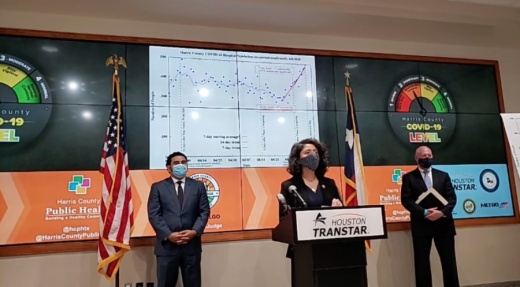That was how Umair Shah, executive president of Harris County Public Health, characterized the current situation in the county with regards to COVID-19 at a June 11 press conference.
Shah, along with several other city and county leaders, spoke at the conference about the county's newest effort to gauge the spread of the virus—a threat-level system meant to provide clear guidelines to the public on how they should adjust their behavior based on recent trends.
The Harris County COVID-19 Threat Level System has four tiers, Harris County Judge Lina Hidalgo said:
- Level 4, minimal threat: Chains of COVID-19 transmission are limited and quickly broken. Residents can resume normal activity.
- Level 3, moderate threat: The local health care system is within capacity and the county has demonstrated a reduction in transmissions. Residents can resume contact with others but should remain vigilant.
- Level 2, significant threat: COVID-19 transmissions are significant and uncontrolled. Residents should minimize contact with others, avoid large gatherings and only visit permissible businesses that follow public health guidelines.
- Level 1, severe threat: Outbreaks are present and worsening, and tracing capacity is strained or exceeded. Residents should minimize contact with others and limit all travel to essential trips, such as to grocery stores or pharmacies.
"There is plenty of ICU [intensive care unit] and hospital capacity right now in our hospital systems, and we're working very closely with our partners to monitor that," she said. "However, if the trends we are seeing now get worse of continue to rise, we are at high risk of getting to the point where the threat to the hospital system is severe and we have to backtrack."
While hospitals overall still have space in Harris County, Shah said some hospitals are more full than others. Two hospitals operated by HCPH—the Lyndon B. Johnson Hospital and the Ben Taub Hospital—are nearing capacity.
David Persse, the health authority for the Houston Health Department, said the county has seen a spike in people being hospitalized in general beds. According to the Southeast Texas Regional Advisory Council, about 8,000 general beds were occupied in Harris County around late May as compared to more than 10,000 as of June 10. That growth could translate to higher occupancy in ICU beds later on, Persse said.
"Very commonly patients admitted to general-ward beds, in seven to 10 days they either go home or wind up in the ICU," he said.
Officials said the recent increases can most likely be tied to the ongoing loosening of restrictions on businesses and a slate of recent events where people gathered, including Memorial Day and high school graduation ceremonies. Hidalgo said spikes in new hospitalizations typically come two to three weeks after large gatherings, so the full effect of gatherings for recent protests has yet to materialize.
Because restrictions on businesses and travel can only be enforced at the state level, Hidalgo said it is incumbent on residents to do their part to prevent the spread from worsening.
"These orders have always depended on people doing their part," she said. "It is a bit challenging. What we’re appealing to is clear communications and the personal responsibility of our community."





